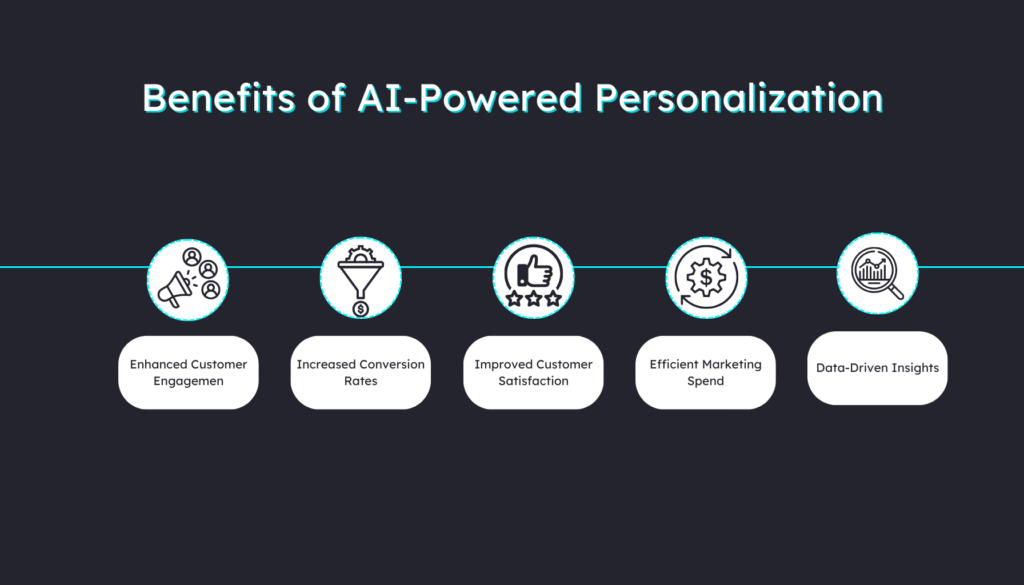
Fostering lasting relationships with customers is not just a goal; it’s a necessity for success. Central to achieving this objective is understanding and enhancing Customer Lifetime Value (Customer LTV). Customer LTV is the lifeblood of a business, representing the total revenue a customer is expected to generate throughout their entire engagement with a company. It’s not just about one-off transactions; it’s about building loyalty and maximizing profitability over time.
To achieve this, businesses are turning to the remarkable capabilities of Artificial Intelligence (AI) to personalize their interactions with customers. AI-powered personalization is not a futuristic concept; it’s a tangible reality that empowers organizations to offer tailor-made experiences to every customer, at scale. We’ll explore how you can leverage AI-powered personalization to increase Customer LTV, drive revenue growth, and secure your position in an increasingly competitive market.
What is Customer Lifetime Value?
At its core, Customer LTV represents the total worth of a customer to a business throughout their entire relationship. It takes into account the revenue generated from each transaction, the frequency of purchases, and the duration of the customer’s engagement with the company. In essence, it answers the question: ‘How much is this customer worth to us over the long term?’
Calculating Customer LTV involves considering variables such as average purchase value, purchase frequency, and customer retention rate. By understanding this metric, you gain insights into the value of investing in customer acquisition and retention strategies.
Why is Customer LTV Crucial for Businesses?
Customer LTV is more than just a number; it’s a strategic compass that guides decision-making across various departments within an organization. Here’s why it’s so vital:
- Strategic Resource Allocation: Knowing the lifetime value of a customer helps you allocate your resources effectively. It allows you to make informed decisions about marketing budgets, customer support investments, and product development efforts.
- Customer-Centric Approach: Customer LTV encourages you to adopt a customer-centric mindset. When you understand the long-term value of a customer, you’re motivated to provide exceptional experiences that foster loyalty and repeat business.
- Competitive Advantage: Those who excel at maximizing Customer LTV are often more resilient in competitive markets. They can invest more in acquiring high-value customers, which can, in turn, lead to sustainable growth.
How Customer LTV Affects Profitability and Sustainability
The impact of Customer LTV on a company’s bottom line cannot be overstated. It directly influences both profitability and sustainability in the following ways:
- Increased Revenue: Customers with a high LTV generate more revenue for you over time. They are more likely to make repeat purchases, refer others, and engage in upsell and cross-sell opportunities.
- Cost Efficiency: High-LTV customers often require less marketing spend for retention than acquiring new customers. This reduces customer acquisition costs and boosts overall profitability.
- Stability and Growth: A focus on Customer LTV promotes stability by reducing reliance on short-term gains. It lays the foundation for sustainable growth, as long-term customer relationships are less susceptible to market fluctuations.
Challenges in Increasing Customer LTV
While the concept of Customer LTV is straightforward, increasing it can be challenging. Some common hurdles include:
- Data Quality and Availability: Accurate LTV calculations require robust customer data, which may be incomplete or inaccurate in some cases.
- Customer Churn: Preventing customer churn is essential for maximizing LTV, but it’s easier said than done. Retention strategies must be effective to keep customers engaged.
- Balancing Acquisition and Retention: Striking the right balance between acquiring new customers and retaining existing ones can be a complex task, especially when resources are limited.
- Competitive Pressures: Rival companies often employ aggressive marketing tactics, making it harder to retain customers and increase their value.
The Power of AI in Personalization
Artificial Intelligence refers to the simulation of human intelligence in machines, enabling them to perform tasks that typically require human intelligence. These tasks encompass learning, reasoning, problem-solving, and, most relevantly, adapting and responding to data. AI has evolved significantly in recent years, particularly in the field of machine learning, which enables systems to improve their performance through experience.
In an era characterized by data-driven decision-making and hyper-connected consumers, the role of AI in personalization is becoming increasingly important.
AI’s role in enhancing customer experiences is transformative. It enables you to move beyond generic, one-size-fits-all interactions and create personalized experiences for each customer. Here’s how AI achieves this:
- Customer Profiling: AI algorithms analyze vast amounts of customer data, from purchase history to online behavior in order to build detailed customer profiles. These profiles help you understand individual preferences and needs.
- Predictive Analytics: AI can predict customer behavior, such as what products a customer is likely to purchase next or when they might be ready to make a buying decision. This allows you to offer timely and relevant recommendations.
- Real-time Personalization: AI can adapt interactions with customers in real time. For example, Pathmonk Accelerate can tailor its website experiences based on the customer’s specific inquiries and previous interactions in order to achieve a 50% conversion increase.
- Segmentation and Targeting: AI can segment customers into groups with similar preferences and behaviors, allowing you to craft marketing campaigns and offers that resonate with each segment.
Increase +180%
leads
demos
sales
bookings
from your website with AI
Get more conversions from your existing website traffic delivering personalized experiences.

How AI Collects and Analyzes Customer Data
AI’s prowess in personalization hinges on its ability to collect and analyze vast amounts of customer data. This process involves:
- Data Collection: AI systems collect data from various sources, including website interactions, social media, mobile apps, and purchase history. This data can be both structured (e.g., demographics) and unstructured (e.g., social media comments).
- Data Preprocessing: AI algorithms clean and preprocess the data, ensuring it’s accurate and usable. This step is critical for preventing errors in analysis.
- Pattern Recognition: AI employs machine learning algorithms to identify patterns, trends, and correlations within the data. This helps in understanding customer preferences and predicting future behavior.
- Personalization Models: AI builds personalization models based on the insights gained from data analysis. These models drive personalized recommendations, content, and interactions.
Benefits of AI-Powered Personalization
The adoption of AI-powered personalization brings numerous benefits to businesses and customers alike:
- Enhanced Customer Engagement: Personalized experiences capture the attention of customers, keeping them engaged and interested in a brand.
- Increased Conversion Rates: Personalized product recommendations and content often lead to higher conversion rates, as they align more closely with individual preferences.
- Improved Customer Satisfaction: When customers feel understood and valued, they are more likely to be satisfied with their interactions, leading to loyalty and retention.
- Efficient Marketing Spend: AI helps optimize marketing spend by directing resources toward the most promising opportunities, reducing wasted efforts on less receptive segments.
- Data-Driven Insights: AI generates valuable insights from customer data, helping you refine your strategies and adapt to changing customer needs.

Leveraging AI for Personalization and Enhanced Customer LTV
AI-powered personalization is a game-changer when it comes to tailoring customer experiences, ultimately improving your Customer LTV.
Collecting Customer Data
Gathering customer data is the foundation of AI-powered personalization. This involves various techniques, including:
- Website Tracking: Tracking customer behavior on your website, such as page views, click-through rates, and time spent on each page.
- Purchase History: Recording transactional data, including what customers buy, how often they make purchases, and the average order value.
- Social Media Monitoring: Collecting data from social media platforms to understand customer sentiment and engagement.
- Surveys and Feedback: Encouraging customers to provide feedback or complete surveys to gather insights into their preferences.
To create comprehensive customer profiles, consider collecting various types of data:
- Demographic Data: Information about age, gender, location, and other demographic factors.
- Behavioral Data: Data related to customer actions, such as website visits, product views, and search queries.
- Psychographic Data: Insights into customer attitudes, interests, and lifestyle choices.
- Purchase History: Records of past purchases, including product categories and frequency.
Using AI Algorithms for Data Analysis
AI-driven data analysis involves the application of machine learning algorithms to customer data. Key steps include:
- Data Cleaning: Ensuring data accuracy by removing duplicates, correcting errors, and handling missing values.
- Feature Engineering: Creating new data features that can provide valuable insights, such as customer segments or purchase frequency.
- Machine Learning Models: Using algorithms like decision trees, neural networks, and clustering to analyze data patterns.
- Predictive Modeling: Developing models to predict customer behavior, such as what products a customer is likely to buy next.
Through AI-driven analysis, you can identify valuable patterns and trends within customer data, including:
- Seasonal Buying Patterns: Understanding when customers are more likely to make purchases.
- Cross-Selling Opportunities: Discovering which products are frequently purchased together, allowing for targeted recommendations.
- User Segmentation: Grouping customers with similar characteristics or behaviors for personalized marketing strategies.
Personalization Strategies
AI opens the door to a wide array of personalization strategies that can enhance the customer experience:
- Product Recommendations: AI algorithms can suggest products to customers based on their browsing and purchase history. Collaborative filtering, content-based filtering, and hybrid approaches can be used to fine-tune recommendations.
- Content Recommendations: Tailor website content, blog articles, or video suggestions based on customer interests and behavior.
- Personalized Emails: Craft personalized email campaigns, including product recommendations and tailored content, to boost engagement and conversions.
- Dynamic Website Content: Display dynamic content on your website, such as personalized landing pages or homepage banners, to capture customer attention.
AB Testing, Multivariate Testing and Optimization
- Implement AB or multivariate testing to evaluate the effectiveness of personalization strategies.
- Continuously optimize personalization efforts based on performance metrics and customer feedback.
- Experiment with different personalization techniques to find what resonates best with your audience.
Measuring the Impact on Customer LTV
Implementing AI-powered personalization is an investment in the long-term success of your business, and measuring its impact on Customer LTV is crucial to evaluate the effectiveness of your efforts. These are the metrics that you should be taking into account:
- Customer LTV: Begin by tracking changes in Customer LTV before and after implementing AI-powered personalization. This is the most direct indicator of success.
- Conversion Rates: Measure the impact of personalized recommendations and content on conversion rates for various customer segments.
- Customer Retention: Analyze whether personalized experiences contribute to improved customer retention rates and reduced churn.
- Average Order Value (AOV): Examine whether AI-driven product recommendations and upselling strategies lead to higher AOV.
- Customer Engagement Metrics: Monitor metrics like click-through rates, open rates for personalized emails, and time spent on personalized website content.
Conclusion
In an age defined by ever-evolving consumer expectations, the power of personalized experiences cannot be underestimated. The fusion of Artificial Intelligence and personalization has ushered in a new era of customer engagement, one that transcends generic interactions to forge deeper, more meaningful connections.
By understanding and maximizing Customer LTV, you are not only securing your present but fortifying your future. The journey we’ve embarked upon in this blog post has unveiled the intricacies of leveraging AI-powered personalization as a strategic imperative.
Remember, as we look ahead, the possibilities are boundless. The landscape of AI and personalization is ever-evolving, presenting fresh opportunities and challenges. Staying at the forefront of these advancements will undoubtedly be the hallmark of industry leaders.





